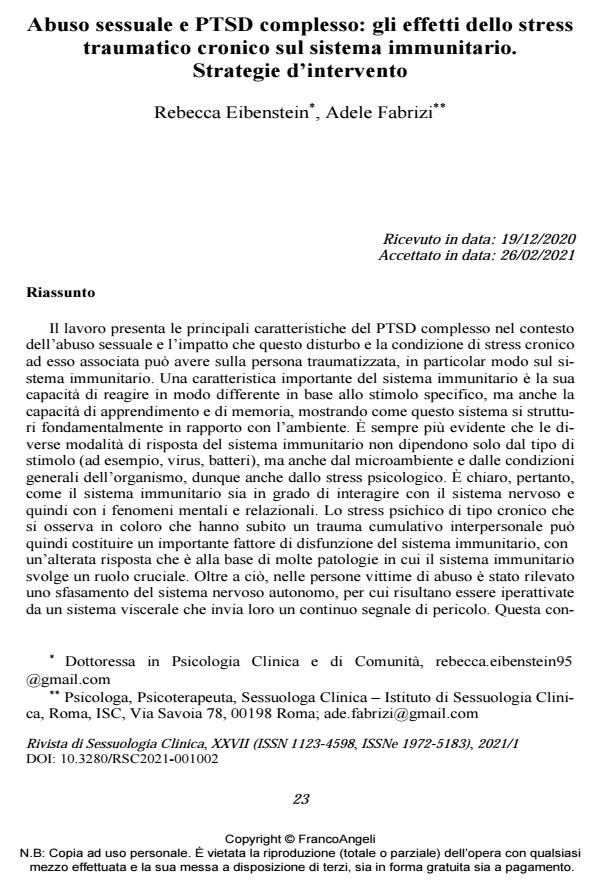Sexual abuse and complex PTSD: the effects of chronic traumatic stress on the immune system. Intervention strategies
Journal title RIVISTA DI SESSUOLOGIA CLINICA
Author/s Rebecca Eibenstein, Adele Fabrizi
Publishing Year 2021 Issue 2021/1
Language Italian Pages 21 P. 23-43 File size 225 KB
DOI 10.3280/RSC2021-001002
DOI is like a bar code for intellectual property: to have more infomation
click here
Below, you can see the article first page
If you want to buy this article in PDF format, you can do it, following the instructions to buy download credits

FrancoAngeli is member of Publishers International Linking Association, Inc (PILA), a not-for-profit association which run the CrossRef service enabling links to and from online scholarly content.
This paper shows the main features of complex PTSD in the context of sexual abuse and the impact that this disease, with the consequent chronic stress condi-tion, may have on the traumatized patient, in particular on the immune system. The immune system has the ability to react in different ways to different stimuli. Moreover, learning and memory ability are demonstrated, showing how this sys-tem is intrinsecally connected to the environment. There is a growing evidence that the different response patterns of the immune system do not depend only on the type of stimulus (for example, virus, bacteria), but also on the microenvironment and on the general condition of the whole physiology, and therefore on the psy-chological stress too. Thus, it is clear how the immune system is able to interact with the nervous system and consequently with mental and relational phenomena. The chronic psychological stress observed in those who have suffered by cumula-tive interpersonal trauma may be considered an important factor with a negative effect on the immune system function and may lead to a dysregulation of the immune response that is the basis of many pathologies in which the immune sys-tem has a key role. Furthermore, a shift in the autonomic nervous system of vic-tims exposed to sexual abuse has been detected, so that they have an hyperac-tivated visceral system that sends a continuous threatening feedback. This condi-tion also has severe consequences on interactive and social capabilities, with a se-vere impact on the psychophysical well-being of the person. For this reason, it is necessary to develop interventions based on a multidisciplinary and biopsychoso-cial approach that could help the traumatized people both to retune autonomic state to enable spontaneus social engagement and trust, and to heal the emotional and somatic components of the traumatic experience.
Keywords: complex PTSD, chronic stress, sexual abuse, immunity, immune dis-function, inflammation.
Rebecca Eibenstein, Adele Fabrizi, Abuso sessuale e PTSD complesso: gli effetti dello stress traumatico cronico sul sistema immunitario. Strategie d’intervento in "RIVISTA DI SESSUOLOGIA CLINICA" 1/2021, pp 23-43, DOI: 10.3280/RSC2021-001002